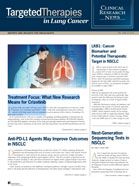Next-Generation Sequencing Tests in NSCLC
A key to improved outcomes for patients with non-small cell lung cancer (NSCLC) is the ability to identify the wide spectrum of genetic changes present in tumors. Doing so will guide treatment decisions and influence the development of much-needed additional targeted therapies.
A key to improved outcomes for patients with non-small cell lung cancer (NSCLC) is the ability to identify the wide spectrum of genetic changes present in tumors. Doing so will guide treatment decisions and influence the development of much-needed additional targeted therapies.
Since 2004, development of sophisticated next- generation sequencing (NGS) technology has allowed for the comprehensive sequencing of entire cancer genomes, exomes, and transcriptomes.1
“With NGS, our diagnostic capability has outpaced what we have in the therapeutic armamentarium, but this may change,” said Benjamin P. Levy MD, director of thoracic medical oncology at the Mount Sinai Beth Israel Hospital in New York, regarding the significance of this testing.
Aside from the sheer volume of data generated by NGS analysis, evidence is emerging that targeted NGS may be more accurate than some other currently used techniques. At the American Society of Clinical Oncology (ASCO) 2014 Annual Meeting, Ali and colleagues presented retrospective data comparing the efficacy of fluorescent in situ hybridization (FISH) with targeted NGS for the detection ofALKrearrangements in 1070 lung carcinomas. They concluded that targeted NGS may be more sensitive in detectingALKrearrangements than FISH in lung cancer, and proposed fur- ther analysis in a prospective study.2
NGS PlatformsSeveral NGS platforms are now available for clinicians, and Levy pointed out that, “Given the rapid development of competing NGS platforms, I think clinicians remain confused regarding which platform is optimal in clinical practice.”
Commonly used NGS technologies are those produced by Illumina (High Seq Analyser),3Roche (454 GS FLX + System),4Applied Biosystems (SOL- ID 4 System),5and Life technologies (Ion Torrent).6Illumina High Seq Analyser and SOLID use optical detection of fluorescence-labeled nucleotides and fluorescence-labeled nucleotide octamers, respectively. The Roche 454 GS FLX uses optical detection of fluorescence evoked by pyrophosphate release during base incorporation, while Ion Torrent employs semiconductor detection of hydrogen ions released as a consequence of nucleotide incorporation.7
OmniSeq Target has been approved by the New York State Department of Health for genomic testing of patients with cancer. OmniSeq Target uses both Ion Torrent and Illumina sequencing plat- forms. It specifically analyzes 23 cancer-associated genes (eg,ALK,EGFR, PTEN) to identify mutations for which there are approved therapeutic agents.
“Focus on actionable mutations is what makes our approach unique and what makes this test such an important tool in therapeutic decision making,” said Carl D. Morrison, MD, DVM, execu- tive director of the center for personalized medi- cine at Roswell Park Cancer Institute in Buffalo, New York, where the test was developed.8
“At the moment, I order molecular testing forEGFRby a Sanger-based approach andALKby FISH for all my advanced-stage lung adenocarci- noma patients,” Levy said. “If the tests are negative and the patient has the appropriate clinical pheno- type (never-smoker), I will consider ordering NGS with the goal of finding a genetic alteration that may guide me in finding the right clinical trial for a patient,” he stated.
The cost of NGS testing has also been a consideration, but, Levy said, “As costs reduce, it may be that people will perform NGS routinely for all patients in anticipation of new drugs being available.”
The Cancer Genome Atlas and NSCLC
A major player in the quest to analyze cancer genomes using NGS technology is The Cancer Genome Atlas (TCGA), a coordinated effort to accelerate understanding of the molecular basis of cancer through the application of genome analysis technologies, including large-scale genome sequencing.9,10
A recent issue ofNaturereported that TCGA has developed a comprehensive molecular profiling of lung adenocarcinoma using samples of tumor and matched normal material from 230 previously untreated patients. Among the samples studied, 76% had somatic evidence of RTK/RAS/RAF activation. The results also suggested there remain unknown mechanisms by which the pathway is activated, opening the door to investigating inhibition of other possible target alterations, including MET and ERB2/HER2. The authors stressed the importance of their discovery of inactivating mutations of MGA, a global positive gene regulator, highlighting a role for the MYC pathway.10
Clearly, data from NGS will identify more targets for clinical trials, and, referring to NSCLC, Levy said. “One such trial in lung cancer, is the Lung-MAP study launched by the National Cancer Institute, which is utilizing Foundation One’s next generation platform to help select targeted thera- pies for patients with squamous cell carcinoma.”
The data acquired by NGS will increase understanding of the genomic alterations in NSCLC, lead to more efficacious personalized treatments, and avoid prescription of inappropriate therapeutic agents. It may also help assess an individual’s risk of developing cancer and lead to development of risk reduction.10,11
References
- Ross JS, Cronin M. Whole cancer genome sequencing by next-generation methods.Am J Clin Pathol.2011;136:527-539.
- Ali SM, Ou SHI, He J, et al. IdentifyingALKrearrangements that are not detected by FISH with targeted next-gen- eration sequencing of lung carcinoma.J Clin Oncol.2014;32:5s (suppl): Abstract 8049.
- Illumina. http://www.illumina.com/systems.ilmn. Accessed August 9, 2014.
- 454 Sequencing Roche. http://454.com. Accessed August 9, 2014.
- Life Technologies. Applied Biosystems. http://www.applied- biosystems.com.au. Accessed August 9, 2014.
- Life Technologies. Ion Community. http://www.iontorrent .com. Accessed August 9, 2014.
- Daniels M, Goh F, Wright CM, et al. Whole genome seq- uencing for lung cancer.J Thorac Dis.2012;4:155-163.
- Roswell Park Cancer Institute. https://www.roswellpark .org/media/news/roswell-park-cancer-institute-genomic- sequencing-test-wins-new-york-state-approval. Accessed August 5, 2014.
- The Cancer Genome Atlas. http://cancergenome.nih.gov/ abouttcga/overview. Accessed July 19, 2014.
- The Cancer Genome Research Atlas. Comprehensive molecular profiling of lung adenocarcinoma Nature. 2014;511;543-550.
- Daniels M, Goh F, Wright CM, et al. Whole genome se- quencing for lung cancer.J Thorac Dis.2012;4:155-163.
Survivorship Care Promotes Evidence-Based Approaches for Quality of Life and Beyond
March 21st 2025Frank J. Penedo, PhD, explains the challenges of survivorship care for patients with cancer and how he implements programs to support patients’ emotional, physical, and practical needs.
Read More
